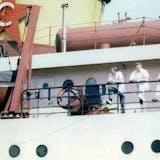Papa Felipe's was the first place I headed when my flight landed in Albuquerque. Known for making the "meanest margarita in town," the restaurant also has been praised for its spicy pork carne adovada -- and I was craving a little of both.
Later, when I found out that a ghostly raven-haired "angel" occasionally visits the room at the historic Hacienda Antigua where I was staying, I was glad I'd had that margarita. Not that I wasn't aware that the Land of Enchantment has attracted its share of intergalactic visitors. New Mexico has always been loaded with mysticism, spirits and creative characters who have been visiting for years, searching for something, often finding it and then never leaving.
Maybe it's the sunshine (approximately 300 days a year). Maybe it's the margaritas (they affect your brain differently in the high altitude). Perhaps it's the colors (who can forget a New Mexico sunset, when the blood-red sun turns the biscuit-colored mountains watermelon pink).
My theory (after one of Papa Felipe's margaritas) is that it's a transcendental mix of all three -- light and spirits and color -- swirled together until everything (including the food) seems enhanced.
Whatever it is, it's some powerful mojo.
Most folks fly into Albuquerque, get their rental car and hightail it immediately an hour north on Interstate 25 to Santa Fe. You can't blame them. Santa Fe has always been the pretty and charismatic one -- Albuquerque, the wilder, quirkier cousin.
But making my home base in Albuquerque at the Hacienda with a nightly hot tub soak beneath a sky full of stars, I managed to enjoy the best of both towns on a somewhat smaller budget.
Serene, calm Albuquerque


